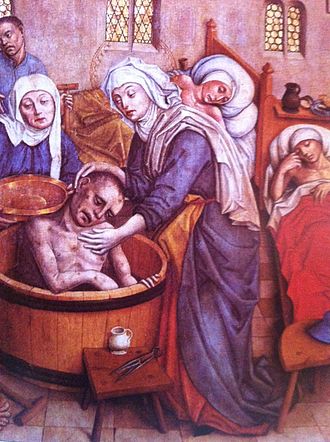The saint today is one of the patrons of Hungary, Elizabeth (+1320), the niece of Saint Hedwig of Silesia, (+1243) whom we celebrated in October. Elizabeth belongs to the ’24’ club – saints who died at that youthful age, or thereabouts – Saint Therese, Pier Giorgio, Gemma Galgani – all having fulfilled a long space in a short time. And Elizabeth certainly did. In 1221, at the age of 14 (still the minimum in canon law), she was married to Ludwig IV, Landgrave of Thuringia, and they lived a happy conjugal life until her husband’s untimely death six years later, while she was pregnant with their third child. He himself had been quite content with his wife’s devotional life: Her strict regime of prayer, her generous almsgiving and feeding of the poor, although it is told that he drew the line at coming home and hearing his wife had placed a leper in their marriage bed – and we might sympathize with the man. But when he drew back the covers in indignation, there instead was Christ crucified on the Cross. Strange things happened in that age of Faith, and who are we to gainsay?
There is also the story of her husband – or perhaps her uncle, who was not so well-disposed towards her – meeting Elizabeth as she was bringing food to the poor. To ensure in the presence of his nobles that she was not stealing riches from the treasury, he asked to see what was in her apron, and when she opened it, beautiful and miraculous red and white roses fell to the ground, reminiscent of the future miracle of Juan Diego.
Hearing of her husband’s demise on September 11, 1227, she lamented: He is dead. He is dead. It is to me as if the whole world died today. After that, Elizabeth threw herself fully into religion and a preparation for eternity.
She made a vow of obedience to her spiritual director, Konrad von Marburg, who seems to have been inordinately strict with her – but one wonders who was the stricter, he with her, or Elizabeth with herself. Like the little seers of Fatima, she seems to have ‘seen’ eternity close-up, with the vanity of this passing world, with all its pleasures and fancies, so ethereal and unreal. She made a promise of celibacy – hindering her family’s dynastic ambitions – and moved out (or was kicked out, depending on which version) of her castle, moving to Marburg, where she built a hospital, in those days well before public medicine. There she herself tended to the sick, the suffering and the poor, amongst whose number she soon counted herself, going peacefully to her eternal reward a few years later, on this November 17 in 1231 after a full life, at the age when most young women – and, yes, young men – in the Western world are still wandering and wondering what to do with themselves.
Such was Elizabeth’s reputation for holiness, along with the abundance of miracles through her intercession, that she was canonized just shy of five years later, by Gregory IX on May 27, 1235. Her tomb was a very popular place of pilgrimage for many years, and a grand church built in her honour by the Teutonic Knights. Alas, devotion has faded of late, but I was at an Irish celidh last evening at a church dedicated to her in Toronto. Elizabeth does seem to be interceding for her native Hungary, which is more sane, and hence doing better, than most places descending into madness.

One wonders how many know her story. The magnificent Elizabethekirche still stands as a wonderful testament of her life. Elizabeth is amongst the heavenly host in heaven, waiting for our prayers and requests.
So send them along – you never know what miracles might be sent your way.
Saint Elizabeth, ora pro nobis! +











